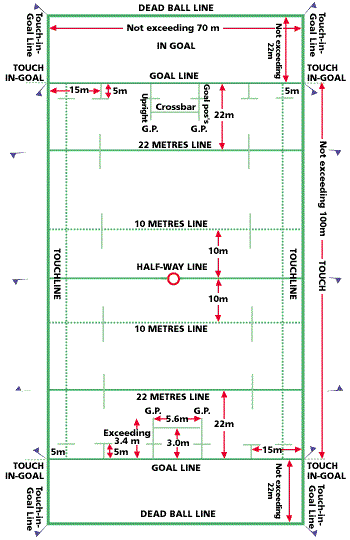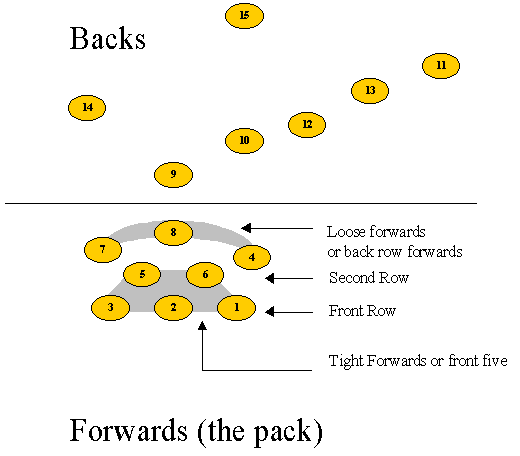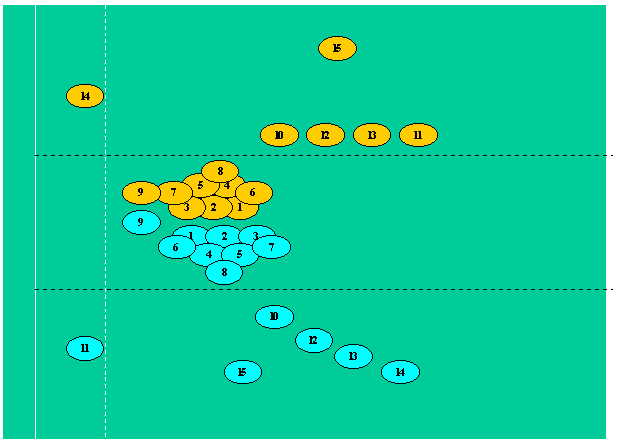|
ROOKIE RUGBY PRIMER
The General Principles
Rugby has two major variations, rugby union and rugby league. League is a game which originated from union but
is based on a much different set of principles. Scrum.com's focus is on Rugby Union. Please contact your local club for additional
information concerning our sport and to learn to play safely.
Presented below are the general principles of rugby union matches:
Forward passes are not allowed. Dropping the ball forward is also prohibited and is called a knock-on.
The ball can only be advanced by running or kicking the ball forward.
A tackled runner must immediately release the ball, the tackler must immediately release the tackled
player.
Play is continuous, all stoppage of play must be immediately restarted (unless there is an injury).
A scrum restarts play after a forward pass or knock-on, a scrum can also be awarded in other situations.
A lineout restarts play after the ball travels into touch (out of bounds).
No blocking, normally all supporting players must stay behind the ball carrier.
A Try is awarded when the ball is carried or kicked across the goal line and downward pressure applied
to the ball. A try is worth 5 points
2 points is awarded for a successful conversion kick after a try.
3 points is awarded for a successful penalty or drop goal kick.
After points are scored, the ball is kicked back to the scoring team (except in sevens).
The game is governed by laws not rules, the referee is the sole enforcer of those laws.
The game clock is kept by the referee on the pitch and is stopped only for injury. The time spent attending
to injuries is added to the end of each half and is called injury time.
Two additional judges are utilized on each touchline to signal when the ball has left the field of play,
and to assist the referee in various capacities.
Rugby Pitch Layout:

Game Start
A coin toss determines the team which will kickoff first. The kicking team will send their forwards
to one side of the pitch at the 50 metre line. The opposing forwards will move in front of their opposites, but spread out
behind the 10 metre line in preparation to receive the kick.
The kicker, who can be any member of the team, will set the ball on the ground and start the match
on the referee's whistle most often kicking the ball high and short to the opposing forwards (he can also kick it long and
deep or away from the forwards if desired). The kick must travel forwards at least 10 metres and land in bounds. The kicker's
forwards will charge down the pitch attempting to catch the ball themselves. If a receiving team's forward successfully catches
the ball, he will attempt to advance the ball normally running into a large amount of opposition. His supporting forwards
will then often bind around him to prevent him being brought to the ground and losing possession of the ball.
The second half of a match is started in the same way except the teams have switched ends of the
pitch and the team starting the match kicking now receives the ball.
Rucks & Mauls
If the ball is held up off the ground, once more than any two players have bound together a maul
is formed. If the ball has gone to ground, then the group of bound players is called a ruck. The very important principle
of rucks and mauls is that once they are set, two imaginary offsides lines become present at the back of each team's rucking/mauling
players extending from touchline to touchline. Any player running into the zone who is not joining the ruck or maul, from
behind this line, before the ball leaves is considered offside and a penalty can be awarded to the other team.
A simple representation of this concept is as follows:
Penalties
Offside is the most common penalty during a match. If a penalty is awarded within goal kicking distance
of a team's kicker, the team captain may elect to have the kicker take an uncontested place kick at goal for three points
from a spot determined by the referee called a mark. If the kick is successful, play is restarted at the 50 metre line with
a drop kick back to the scoring team. After an unsuccessful penalty kick, play is usually restarted by a drop kick (a kick
executed by allowing the ball to hit the ground before kicking it) to the kick attempting team from the 22 metre line. This
restart is called a 22 metre dropout.
Other common penalties include violent play, barging, not releasing the ball, obstruction (blocking)
and diving over a collapsed ruck. Other options available to a team awarded a penalty include restarting play by a tap kick
through the mark with the opposing team ten meters away or an uncontested kick to touch which is awarded back to the team
receiving the penalty award.
For minor infringements such as a foot up in the scrum, a free kick can be awarded. A free kick is
just like a penalty kick except it cannot be taken directly at goal and if it goes to touch, the other team is awarded the
ball for the lineout.
More on Running & Tries
If and when the ball is produced from a ruck or maul without penalty, usually by the scrumhalf, the
ball will most often be passed to a forward charging back through the defence or to the flyhalf who has pre-determined a course
of action.
The flyhalf is the person normally determining all moves which the backs will run. Once he has received
the ball he will then start a run, make a pass, or kick the ball. All of this must be done very quickly as the opposing backs
and forwards will be quickly rushing up to tackle whomever has the ball.
The moves the backs run will include a number of different manoeuvres and ploys to put the backs
into open running space. Common running tactics include loops, switches, dummies, and miss passes. A loop is where a player
will make a short pass to another and then run around to the other side of that player to receive a return pass. A switch
is where two players will cross paths allowing the ball carrier to pass behind himself to a runner running on a different
angle. A dummy is a faked pass to another runner freezing or decoying the defender. A dummy switch is a switch where the ball
carrier does not pass the ball to the crossing runner. A miss pass is a pass which is thrown past the first immediately available
supporting player to runners further past him.
When the ball is being run, a player tackled to the ground must immediately release the ball (the
defender tackling the runner must release the runner after the tackle) making it available to both teams. Typically the tackled
player will attempt to place the ball closest to his own supporting players. Those supporting players will make a decision
to pickup the loose ball or drive over the ball and tackled player to bind together into a new ruck. The defending team will
do the same thing in an attempt to push the attacking team backwards. If the ball is picked up and advanced again by either
side, a maul can quickly ensue if the advance is checked by the defence and the ball does not go to the ground. Each time
a successive ruck or maul is set, it is described as a phase of play.
Once a player makes a break over the tryline, he must touch the ball down to the ground to be awarded
the 5 points for the try. If he loses the ball in the dead ball area, the ball will come out and play will be restarted with
a 22 metre dropout. Often a player will cross the tryline close to one of the touchlines and will turn back towards the posts
before touching down. This is done to provide a better angle for the person attempting the conversion kick. The kick for extra
points must be taken from a mark perpendicular to the spot where the try was touched down. Thus the kicker's job is typically
made much easier when the try is awarded centered between the posts.
The conversion kick is a place kick taken immediately after the try and worth 2 points. The defending team must retreat behind
the tryline but can rush the kick once the kicker makes a move towards the ball to kick it through the uprights.
Tactical Kicking
Most tactical kicks by the flyhalf will be to advance the ball upfield and into touch. He will take
this option most often to clear the ball during heavy pressure. He can also kick the ball forward expecting a fast charging
back to recover the ball before the opposition. Any person chasing a kick must have started the chase from behind the kicker
or have been previously overtaken by the kicker or someone who was behind the kicker. Thus anyone in front of a kick is offside
until put onside by the kicker or someone who was behind the kicker.
Another important aspect of tactical kicking is that a kick to touch from behind the 22 metre line
is marked at the point the ball left the pitch. A kick taken in front of the 22 metre line must land in field or a touch a
player on the field before going into touch, otherwise the line-out is awarded at the location of the kick and not where it
went out. A penalty kick in front of the 22 is allowed to be kicked directly to touch.
Other tactical kicks include a drop goal kick, an up-and-under, chip and grubber kicks. When a team
is putting good pressure on the opposing side's tryline, a player can decide to attempt a drop kick at goal for three points.
The ball must be dropped and touch the ground before being kicked through the goal posts to be awarded. An up-and-under is
a kick placed very shallow and very high. The idea is to put the receiving opposition players under incredible pressure and
give your own players the time to get underneath the descending ball. A chip kick is best utilized in an open field situation
by a runner who is about to be stopped. As a player cannot be tackled without the ball in hand, a runner can kick the ball
just over an onrushing defender allowing the runner, or supporting runner, to go past untouched hoping to recover the kick.
A grubber kick is in principle much the same as a chip kick, but is kicked along the ground.
Rugby Positions

Forwards
#1 Prop )
)
#2 Hooker )
The Front row )
#3 Prop )
)
The tight forwards
#4 Lock )
The Second )
#5 Lock )
Row )
#6 Flanker or wing
forward )
#7 Flanker or wing
forward ) The loose forwards
#8 Number 8 or
eight man )
Backs
#9 Scrumhalf
#10 Flyhalf )
#11 Wing )
#12 Inside Center
) The three quarters
#13 Outside Center
)
#14 Wing )
#15 Fullback
Scrum Formation:
Scrums
Very often a player will lose the ball forward during a tackle or just while running and
receiving a pass, thus knocking-on. If the ball is quickly picked up by the other team, the referee will let play continue
to allow the recovering team to take advantage of the mistake. If no advantage occurs, then the referee will whistle for a
scrum to be set at a spot he indicates on the pitch also called a mark. The team that did not lose the ball is awarded the
ball to put into the scrum. A scrum is also awarded whenever a pass is made in which the ball goes forward.
The typical procedure of scrummaging involves each set of front row players binding and the
hookers calling for the locks to join the formation. The flankers join on each side of the locks setting their shoulders below
a prop's outside buttock. The No. 8 joins at the back between the hips of the two locks. While this is occurring the captain
of the forwards can be calling a move while the backs are shouting out code words signalling what move they will be running.
The forward pack with the put in is then allowed the courtesy of initiating the coming together of the scrum. Upon a prearranged
signal between the hooker and scrumhalf, the scrumhalf will roll the ball into the tunnel underneath the two locked together
front rows. Each of the hookers will then attempt to push the ball behind him with a sweep of his foot. All of this is occurring
while each pack is attempting to push the other backwards driving themselves over the ball.
If the ball is won cleanly, most often the scrumhalf will run to the back of the scrum to
retrieve the ball from in front of the No. 8's feet and pass it to the backs, to a breaking loose forward, or make a run or
kick of his own. The opposing scrumhalf will follow looking for a chance to snap up any loose ball. The No. 8 may also decide
to pick up the ball himself, and start a back row move from the back or base of the scrum.
Following is a simple representation of how the players will line up at the start of a scrum
awarded on the left side of the pitch:

One exciting aspect of scrummaging is the pushover try. A pushover try is scored when a scrum is set close
to the attacking tryline. The attacking scrum will keep the ball at the No. 8's feet driving the defending pack backwards
across the tryline. Once the ball has been dragged across the tryline, the No. 8 or scrumhalf will touch the ball down for
the try.
Lineout Formation:
Lineouts
A scrum is called a set piece. The other common set piece in rugby is the lineout. After a ball
has been kicked or run into touch (out of bounds), the forwards of each team will line up at the spot indicated by the touch
judge as the touch mark. Normally, the hooker of the team being awarded the ball will be the person to throw the ball back
into the lineout. The other forwards will lineup at least 5 metres away from him but no further than 15 metres. The opposing
team will lineup to match their counterparts. Someone on the team with the throw-in will call a coded signal indicating who
the ball will be thrown to and any subsequent move. At the same time the flyhalf should also be calling a move. The hooker
will then throw the ball to the intended receiver who has jumped into the air. Most often the throw is to the locks who are
jumping in the second and fourth positions in the lineout supported by the players on either side of them. Once a jumper does
jump, these supporting players are allowed to lift him higher into the air and hold him there. Once the ball is secured, most
often many of the forwards on both sides of the ball bind together and a maul will ensue until the ball is produced for another
phase.
The most typical positioning of attacking players during a lineout on the left side of the pitch
is as follows:

Sevens & Tens
Sevens is typically played only during tournaments. A sevens match consists of two seven minute
halves and is a much faster game than fifteens due to the smaller number of players on a standard sized pitch providing ample
running space. The players on a sevens team are as follows:
Forwards
Backs
The same general game principles are used except tactics are quite different. Scrums feature only
opposing front rows. Rucks and mauls are very fast and small, with defense and tackling of paramount importance to reduce
the many opportunities for breaks. One major difference from fifteens is that after a penalty goal or try is scored, the ball
is kicked to the non-scoring team from the 50 metre line to restart play.
Tens is played with ten players in combinations of either 5 forwards/5 backs or 3 forwards/ 7 backs. The team
with the scrum feed gets to determine the number of forwards in the scrum. The opposing team is required to match them. The
tens game is a little slower than sevens and has a flow much more similar to fifteens. Each of the halves is ten minutes long.
Tens is also typically only played during tournaments.
All info borrowed from the following:
http://planorugby.tripod.com
http://www.scrum.com/rugby_guide/default.asp
|

